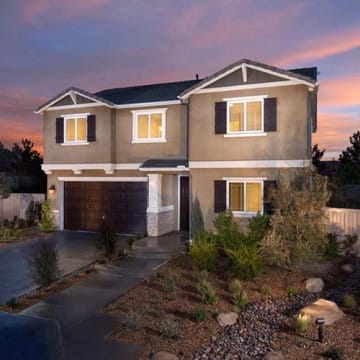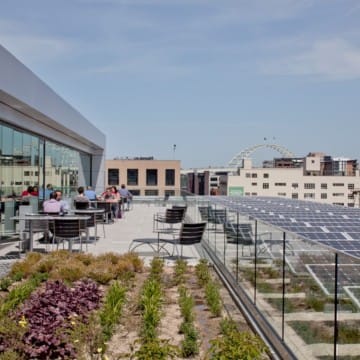High Point
High Point creates a vibrant mixed-income community of 1,529 market-rate and affordable homes on a former public housing complex once marked by crime and unemployment. A HOPE VI redevelopment, High Point is noted for being the first dense urban development in the nation to achieve sustainable, low-impact design at a large scale. On a site that was formerly 65 percent impervious, High Point’s natural drainage system infiltrates 75 to 80 percent of stormwater runoff.
Context
High Point has been cited as “a new model of cooperation” between residents, private developers, and government agencies to create a more sustainable and inclusive community for one of Seattle’s most demographically diverse neighborhoods. This innovative partnership between the Seattle Housing Authority; the departments of Planning, Development, and Transportation; and Seattle Public Utilities was formed to improve water quality for residents of this mixed-income community while protecting the endangered salmon run downstream in Longfellow Creek—one of the last four runs remaining in the city.
To accommodate this cross-sector partnership, in 2003, Seattle passed a special ordinance to permit low-impact-development features throughout the redevelopment of High Point, which would expand to include 1,529 units, 48 percent of which were affordable to low-income families to buy or rent. To balance concerns for neighborhood green space, pedestrian safety, and water quality, the entire street grid was raised and replaced by a natural drainage system that uses a new street network including pedestrian circulation, bioswales, a stormwater pond, porous streets and sidewalks, and multifunctional open spaces to create a positive net impact on the environment.
Innovative Water Management Features
- Pedestrian-friendly streets. Narrowed streets, shortened blocks, strategic alley connections, porches, hidden parking lots, landscaped sidewalks, new utilities, mature and newly planted street trees, and walking groups highlight the aesthetics of stormwater features and promote physical activity.
- Integrated stormwater management system. High Point was the first community in the state to feature permeable pavements in residential streets, sidewalks, parking lots, sidewalks, and basketball courts. A quarter-mile walking trail and gathering space was constructed around a 22-acre-foot retention pond and connected by four miles of grass and vegetated bioswales to naturally manage stormwater, improve water quality, and protect the wildlife habitat on site and nearby.
- Sustainable landscaping. Organic landscaping methods were introduced on more than 20 acres of open space, including front and back yards, gardens, and pocket and neighborhood
parks. Over 100 mature trees have been saved at High Point, valued at more than $1.5 million. Approximately 3,000 trees were planted in High Point as part of the site’s redevelopment. - Green building standards. Public and private developers were held to Built Green standards, a construction checklist and rating system verified by the local Master Builders Association, which included the use of recycled or reused building materials, topsoil, and pavement in the construction of housing and trenches. At a small incremental cost, energy-efficient appliances, windows, doors, and insulation were installed in all units. High Point features 60 Breathe Easy Homes®, independently verified units structurally enhanced to improve interior air quality for residents suffering from asthma.
Value Proposition
After integrating innovative stormwater features, High Point’s public and private developers achieved faster-than-anticipated sales and lease-up rates. Market-rate home and land sale proceeds have added revenue back to the city for neighborhood improvements through property taxes and to the Seattle Housing Authority for the construction of low-income housing through a profit-sharing model with private developers.
High Point’s success in improving the physical, mental, and environmental health of its residents has been reported by several National Institutes of Health studies and served as the model for green building standards in future developments at the Seattle Housing Authority. The community’s commitment to sustainable design and community development for residents of all incomes has garnered numerous awards and documentaries, including a 2007 ULI Global Award for Excellence.
“There was a magical match between people who embraced the ideals and virtues of green living and those who desired to live in a community that looked like America—not segregated, not one color, but a real mix of peoples, cultures, backgrounds, income levels, and so on. That was one of the drivers of pushing, from a marketing perspective, for a green, sustainable community. We saw that those buyers had more than one reason to take note of this new community.” George Nemeth, Senior Housing Developer, Seattle Housing Authority
Lessons Learned
- Large-scale affordable and market-rate housing developments can integrate a high-quality, low-impact design. High Point achieved faster-than-anticipated sales and lease-up rates for over 1,500 mixed-income homes while developing a natural drainage system that infiltrates 75 to 80 percent of stormwater runoff.
- Street grids can manage stormwater runoff while creating a safer pedestrian environment. High Point created an entirely new street grid lined by four miles of vegetated bioswales, more than 2,000 new trees, porous sidewalks, a quarter-mile recreational trail, and multiple traffic-calming measures, supported by walking groups.
- Endangered species can be protected from contaminants through stormwater management. On a site that was formerly 65 percent impervious, High Point contributed to the protection of one of the last four salmon runs in Seattle, Longfellow Creek.


